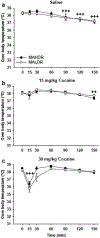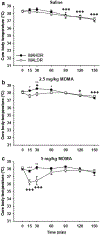Differential genetic risk for methamphetamine intake confers differential sensitivity to the temperature-altering effects of other addictive drugs
- PMID: 31925906
- PMCID: PMC7286770
- DOI: 10.1111/gbb.12640
Differential genetic risk for methamphetamine intake confers differential sensitivity to the temperature-altering effects of other addictive drugs
Abstract
Mice selectively bred for high methamphetamine (MA) drinking (MAHDR), compared with mice bred for low MA drinking (MALDR), exhibit greater sensitivity to MA reward and insensitivity to aversive and hypothermic effects of MA. Previous work identified the trace amine-associated receptor 1 gene (Taar1) as a quantitative trait gene for MA intake that also impacts thermal response to MA. All MAHDR mice are homozygous for the mutant Taar1 m1J allele, whereas all MALDR mice possess at least one copy of the reference Taar1 + allele. To determine if their differential sensitivity to MA-induced hypothermia extends to drugs of similar and different classes, we examined sensitivity to the hypothermic effect of the stimulant cocaine, the amphetamine-like substance 3,4-methylenedioxymethamphetamine (MDMA), and the opioid morphine in these lines. The lines did not differ in thermal response to cocaine, only MALDR mice exhibited a hypothermic response to MDMA, and MAHDR mice were more sensitive to the hypothermic effect of morphine than MALDR mice. We speculated that the μ-opioid receptor gene (Oprm1) impacts morphine response, and genotyped the mice tested for morphine-induced hypothermia. We report genetic linkage between Taar1 and Oprm1; MAHDR mice more often inherit the Oprm1 D2 allele and MALDR mice more often inherit the Oprm1 B6 allele. Data from a family of recombinant inbred mouse strains support the influence of Oprm1 genotype, but not Taar1 genotype, on thermal response to morphine. These results nominate Oprm1 as a genetic risk factor for morphine-induced hypothermia, and provide additional evidence for a connection between drug preference and drug thermal response.
Keywords: addiction; methamphetamine; opioids; thermal regulation; trace amine-associated receptor 1; μ-opioid receptor.
Published 2020. This article is a U.S. Government work and is in the public domain in the USA.
Figures





References
-
- Stenbacka M, Leifman A, Romelsjö A. (2010) Mortality and cause of death among 1705 illicit drug users: A 37 year follow up. Drug Alcohol Rev 29, 21–27. - PubMed
-
- Aoyama N, Takahashi N, Kitaichi K, et al. (2006) Association between gene polymorphisms of SLC22A3 and methamphetamine use disorder. Alcohol Clin Exp Res 30, 1644–1649. - PubMed
-
- Kim M, Custodio RJ, Botanas CJ, et al. (2018) The circadian gene, Per2, influences methamphetamine sensitization and reward through the dopaminergic system in the striatum of mice. Addict Biol 24, 946–957. - PubMed
Publication types
MeSH terms
Substances
Grants and funding
LinkOut - more resources
Full Text Sources
Medical
Molecular Biology Databases
Research Materials

